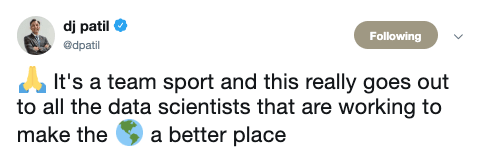To quote DJ Patil, the first Chief Data Scientist of the United States, the most successful organizational transformations are anchored in an approach of data science and the application of AI and ML, as a team sport.
Teams looking to expand into this space must include a breadth of roles, skills, and responsibilities, not just one person with a PhD in Computer Science.
What this does for us as a business:
This removes the pressure from any one person to deliver “the AI”.
It invests in employees to learn new skills that will bring value to their career and their team, learning in the best way that works for
them.It requires teams to work together to develop advanced products that could have impacts at scale that one perspective would miss. If you are a global company, you must have global representation at the table.
It mitigates potential risks by encouraging diversity of thought and problem solving to challenge how “best” to solve a problem.
It immerses all members of a team to understand what kinds of problems AI and ML can solve. This is key for ML and AI adoption in a company and is hardest to teach: how to recognize the kinds of problems these algorithms can solve and how to frame a problem as an AI or ML experiment is the first step in understanding how to build, test and design these systems.
It forces us to question who we are bringing together to solve problems. Does a specific algorithmic change in a deployment lead to a drop in users interacting with a feature? You’ll need someone from the user experience team at the table to help you understand how the constraints you placed on the problem are affecting your desired outcomes.







Top comments (0)